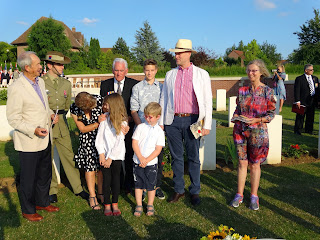When mum and dad moved to Vietnam in 1996, they altered the paths of more than a few lives.
All three of us kids moved back to live with them in this exotic corner of the world, and two of us would meet our life partners there. Mine was from Lille in the north of France, and Emma would meet and marry Charlie, from Adelaide.
Just outside of Lille lies the small town of Fromelles. Two of my wife's uncles can see the town's steeple from their back gardens.
Not many Australians have heard of Fromelles.
They should have: it should have a place in our national conscience as significant as Gallipoli.
The Battle of Fromelles took place on the 19th-20th of July, 1916. It was Australia's first and most disastrous battle on the Western Front, with many soldiers still fresh from the horrors of Gallipoli.
The Australian War Memorial describes the battle as "the worst twenty-four hours in Australia's entire history." with more than five and a half thousand losses. More Australian blood has been spilled on this small patch of earth than anywhere else on the planet.
Many of the fallen were never found, with only their names inscribed on a wall at VC Corner Cemetery after the Great War.
I first visited this area with my parents in 1984 on holiday (at the age of 15), because my mother's great uncle 'Jack' Shrimpton is buried in a small war cemetery just down the road from Fromelles, in Hazebrouck. He was 23. I remember mum being visibly upset at the time, but probably didn't possess the emotional maturity myself at the time to understand why.
It wasn't until many years later whilst visiting the Australian Commonwealth cemeteries outside of Amiens and Villers-Bretonneux with my wife and father-in-law that I could grasp the enormity of it all: rows upon rows of young men (46 thousand from a total Australian population of 4 million would die on the Western Front), many of them scarcely teenagers. I remember openly weeping.
The more recent story of the discovery of an unmarked mass grave in Pheasant Wood is fascinating.
A geophysical survey in 2007 confirmed the remains of 337 soldiers, and exhumations took place from 2009. And with the evolution of DNA techniques, many of these have been positively identified as Australians from living descendants.
I took my wife and children to the dedication of the newest Commonwealth War Graves Cemetery at Fromelles in 2010, and was very moved. And then several weeks before our holiday in France this year, Charlie (my sister's husband) rang to tell me that his own DNA had been used to identify a long fallen soldier. He had just been called by the Commonwealth War Graves Commission to be informed that his great great uncle, John Gordon McKenzie, had been found. There would be an interment on the anniversary of the battle.
Charlie brought his son (my Godson) Hamish, and as Charlie's own father Donald was already holidaying in France with his wife, that made three generations of McKenzies present on the day to see off a long deceased 4th. Hamish was interviewed and made the evening news in Australia.
I felt honoured to be a part of it all, and the sound of the last post rang more poignant than ever.
Although we had all been staying at my parents-in-law's, that night we all camped out under the stars in a small copse near where the young McKenzie would have seen his last moments.
Next day the locals came and rescued us from the mosquitoes and took us back for breaky. Then followed a tour of the town, VC Corner, views from the church steeple, and Hitler's probable bunker. Their hospitality was extraordinary, and a most memorable experience.
It is extraordinary to now have two family graves within coo-ee from my wife's family home.
Lest we forget.












































No comments:
Post a Comment